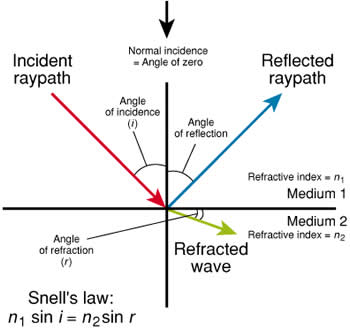Difference between Reflection and Refraction
Key Difference: When the light falls on any surface, a part of that light is sent back to the same medium. This is known as reflection. When the light bounces back from its normal lane, it is termed as refraction.
According to the Dictionary.com, ‘Reflection’ is:
- The act of reflecting or the state of being reflected.
- An image; representation; counterpart.
- A fixing of the thoughts on something; careful consideration.
- A thought occurring in consideration or meditation.
- An unfavorable remark or observation.
 When the light falls on any surface, a part of that light is sent back to the same medium. This is known as reflection. The angle of occurrence and angle of reflection are the same in the case of reflection. The light beam that leaves the surface is called the reflected ray. It merely deals with light and sound. The angle of incidence and angle of reflection are the same in the case of reflection. There are two types of reflection: Specular Reflection and Diffuse Reflection.
When the light falls on any surface, a part of that light is sent back to the same medium. This is known as reflection. The angle of occurrence and angle of reflection are the same in the case of reflection. The light beam that leaves the surface is called the reflected ray. It merely deals with light and sound. The angle of incidence and angle of reflection are the same in the case of reflection. There are two types of reflection: Specular Reflection and Diffuse Reflection.
Specular reflection is the light that is reflected in the same angle. Whereas, in the diffuse reflection, the light reflected from the rough surface is scattered in all direction. It does have the consistency, or it is not angled.
Law of reflection: θi = θr
According to the Dictionary.com, ‘Refraction’ is
- Physics - the change of direction of a ray of light, sound, heat, or the like, in passing obliquely from one medium into another in which its wave velocity is different.
- Ophthalmology
- The ability of the eye to refract light that enters it so as to form an image on the retina.
- The determining of the refractive condition of the eye.
The images that are observed through the glass or any other objects are known as refraction. Let’s take an example of refraction of light – when visible light passes through a transparent material such as glass, air and water, its velocity changes according to the Index of Refraction of the objects. In simple terms, the light changes direction, or ‘bends’ as it passes through the boundary between the two mediums. The best way to differentiate between reflection and refraction is that reflection is found in mirrors while lenses use refraction. The angle of incidence and the angle of reflection are not the same in refraction.
Lenses are the best example for Refraction. There are two types of lenses: Concave lenses and Convex lenses. Convex lenses will produce larger-than-life images and concave lenses will produce smaller-than-life images.
In short, when light enters a new medium at an angle it will bend because it is slowing down. The change in speed causes the ray to bend or change direction.
Refraction is defined by Snell’s law, which states that the angle of incidenceθ1 is related to the angle of refraction θ2 by
sinѲ1 v1 n2
_____ = ___ = ____
sinѲ2 v2 n1
Comparison between Reflection and Refraction:
|
|
Reflection |
Refraction |
|
Description |
Reflection is when light falls on any surface, and a part of that light is sent back to the same medium. |
Refraction usually deforms the image, depending on the angle in which the image hits another plane or surface. |
|
Involves |
It only involves images |
It may also involve sound waves other than images. |
|
Similar |
The angle of incidence and the angle of reflection are similar in reflection. |
The angle of incidence and the angle of refraction are not similar in refraction. |
|
Applied |
Applied in day-to-day activity |
Applied rarely at some specific time. |
|
Medium |
Light travels to the same medium |
Light travels from one medium to another medium |
|
Found in |
Images / mirrors |
Lenses |
|
Examples |
Hair management, cosmetics, beauty arrangements, etc. |
Light properties, sound editing, anything involving science. |
Image Courtesy: lh4.ggpht.com









Comments
areesha
Thu, 02/22/2018 - 07:46
Add new comment